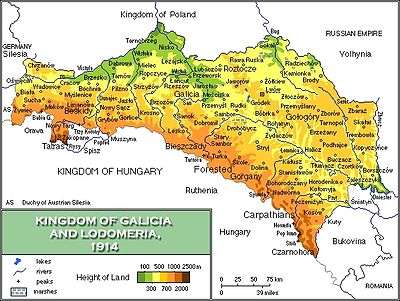Lodomeria

Lodomeria is a placename that was historically used to refer to parts of East-Central Europe, but with a meaning that shifted over time. The word is a Latinized form of the (dubious) Polish: Wladimeria, likely in turn from Old East Slavic, meaning "lands of Vladimir". This refers either directly to the ruler of Kievan Rus, Vladimir the Great (therefore meaning the lands conquered by him), or else refers to the city he founded and named for himself in CE 987, Wlodimer (or Volodymyr).
In the following centuries the name Lodomeria became synonymous with Galicia, broadly defined, or with Volhynia. After the Habsburg annexation of south-eastern borderlands of the Polish–Lithuanian Commonwealth, Lodomeria together with Galicia formed one of the many titles of the Emperor of Austria, "the ruler of Kingdom of Galicia and Lodomeria". However, Lodomeria existed only on paper, had no territory and could not be found on any map.[1]
The American Notes and Queries published in 1889 stated that Lodomeria was an ancient district of Poland situated in eastern portion of the country. In 938 the Ruthenian Grand Prince Vladimir (Wladimir) annexed the principality and named it after himself. In 1198 the nominal title of a ruler of Lodomeria was created by one of his descendants.[2] In 1340 King Casimir reunited Lodomeria with Poland.[2][3][4]
However, the region with the city of Vladimir as its capital was often referred to as the Principality of Volhynia, rather than the Principality of Vladimir. The name "Volhynia" is first mentioned in Ruthenian chronicles as a region inhabited by a tribe called the Volhynians that was conquered by the Grand Prince of Kiev Vladimir the Great. Volhynia changed hands several times throughout the following centuries. Circa CE 1199 it was merged with the Principality of Halych, to form the Duchy (later Kingdom) of Galicia and Volhynia under Prince Roman the Great. After the death of Roman the Great in 1205, Andrew II of Hungary adopted the title of "King of Lodomeria" (as well as of Galicia), in reference to Volhynia. In reality however, Volhynia belonged to the Polish kings, though in 1399, the title of "Kingdom of Galicia–Volhynia" was abolished by the Polish monarchs and merged into Poland proper.
Although the Hungarians were driven out from Halych-Volhynia by 1221, Hungarian kings continued to add Galicia et Lodomeria to their official titles. In 1527, the Habsburgs inherited those titles, together with the Hungarian crown. In 1772, Empress Maria Theresa, Archduchess of Austria and Queen of Hungary, decided to use those historical claims to justify her participation in the first partition of Poland. In fact, the territories acquired by Austria did not correspond exactly to those of former Halych-Volhynia. Volhynia, including the city of Volodymyr-Volynskyi was taken by the Russian Empire, not Austria. On the other hand, much of Lesser Poland did become part of Austrian Galicia. Moreover, despite the fact that the claim derived from the historical Hungarian crown, Galicia and Lodomeria was not officially assigned to Hungary, and after the Ausgleich of 1867, it found itself in Cisleithania, or the Austrian-administered part of Austria-Hungary.
The full official name of the new Austrian province was "Kingdom of Galicia and Lodomeria with the Duchies of Auschwitz and Zator". After the incorporation of the Free City of Kraków in 1846, it was extended to "Kingdom of Galicia and Lodomeria, and the Grand Duchy of Kraków with the Duchies of Auschwitz and Zator" (German: Königreich Galizien und Lodomerien mit dem Großherzogtum Krakau und den Herzogtümern Auschwitz und Zator). Therefore, from 1772 to 1918 "Lodomeria" was claimed by the Austrian monarchs, whereas Volhynia, the region the word had originally referred to, was part of the Russian Empire.
References
- ↑ Elio Corti. "Lessico: Regno di Galizia e Lodomeria". Origine e variazioni del nome. Summa Gallicana: La Genetica del Pollo. Retrieved 11 February 2014.
La Lodomeria esisteva solo sulla carta; non aveva territorio e non poteva essere trovata su alcuna mappa.
- 1 2 William Shepard Walsh; Henry Collins Walsh; William H. Garrison; Samuel R. Harris (1889). American Notes and Queries, Volume 3. Original by Westminster Publishing, Philadelphia from Harvard University. p. 114. Retrieved 24 November 2013.
- ↑ Ian Mladjov. "Galicia and Lodomeria (Galič and Vladimir)" (PDF). Resources. University of Michigan Department of History. Retrieved 24 November 2013.
- ↑ "Galicia". The Encyclopaedia Britannica, Volume 10. Henry G. Allen Company. 1890. p. 26. Retrieved 24 November 2013.